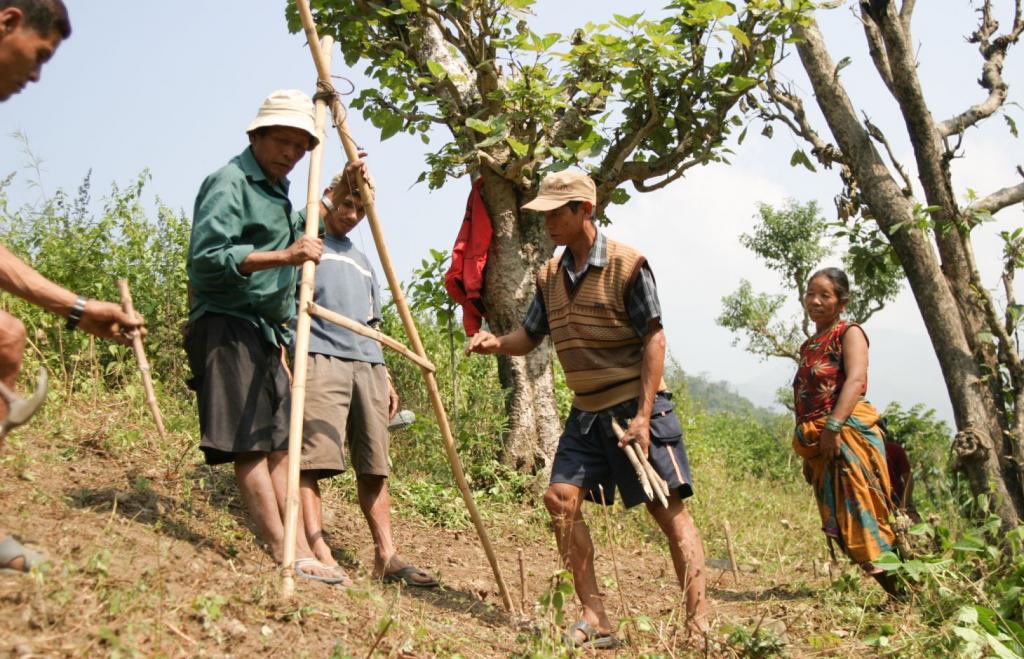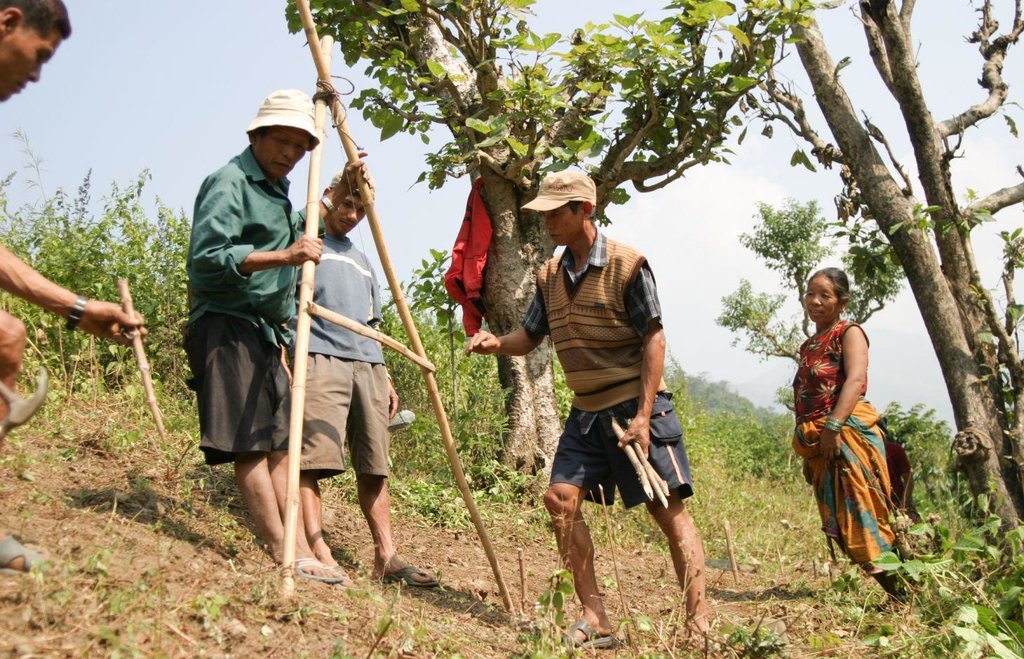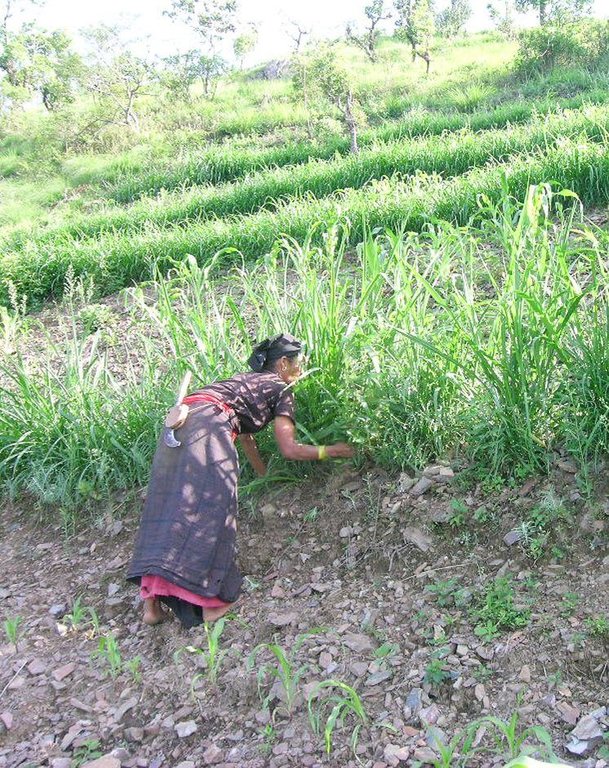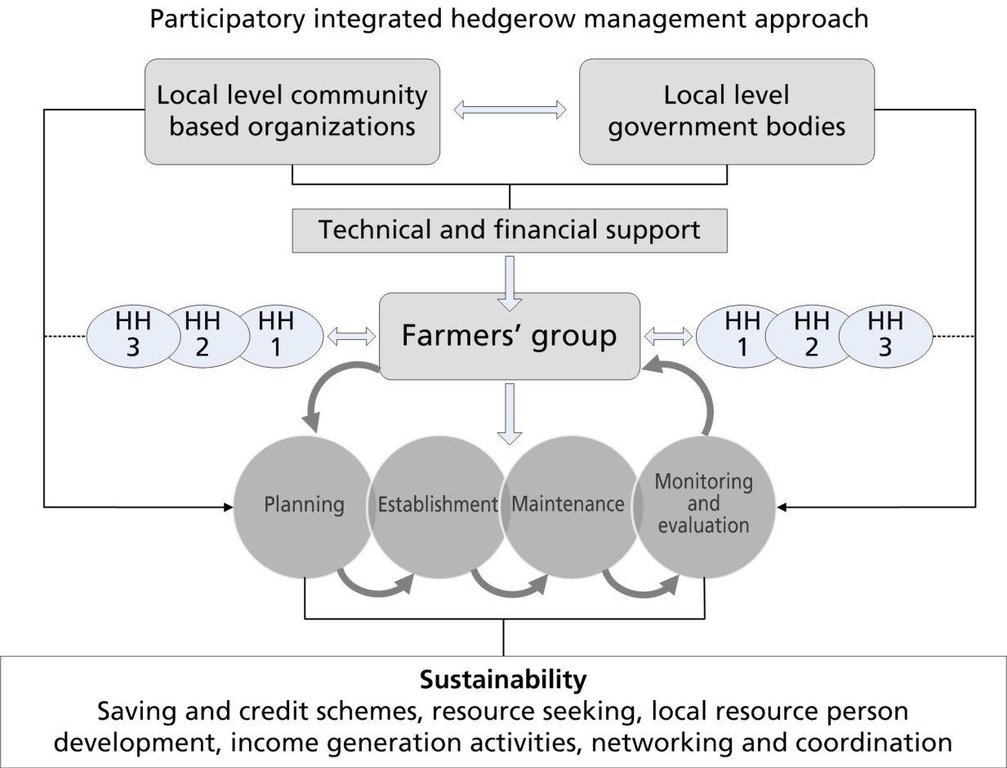Participatory hedgerow management [เนปาล]
- ผู้สร้างสรรค์:
- การอัพเดท:
- ผู้รวบรวม: Shreedip Sigdel
- ผู้เรียบเรียง: –
- ผู้ตรวจสอบ: Fabian Ottiger
Sahabhagitamulak ghasehar bewasthapan (Main Contributor: Gyanbandhu Sharma, LI-BIRD)
approaches_2530 - เนปาล
ดูส่วนย่อย
ขยายทั้งหมด ย่อทั้งหมด1. ข้อมูลทั่วไป
1.2 รายละเอียดที่ติดต่อได้ของผู้รวบรวมและองค์กรที่เกี่ยวข้องในการประเมินและการจัดเตรียมทำเอกสารของแนวทาง
ผู้เชี่ยวชาญ SLM:
ชื่อของโครงการซึ่งอำนวยความสะดวกในการทำเอกสารหรือการประเมินแนวทาง (ถ้าเกี่ยวข้อง)
Local Initiatives for Biodiversity, Research, and Development (LI-BIRD) - เนปาลชื่อของโครงการซึ่งอำนวยความสะดวกในการทำเอกสารหรือการประเมินแนวทาง (ถ้าเกี่ยวข้อง)
ICIMOD International Centre for Integrated Mountain Development (ICIMOD) - เนปาล1.3 เงื่อนไขที่เกี่ยวข้องกับการใช้ข้อมูลที่ได้บันทึกไว้ผ่านทาง WOCAT
วันที่เก็บรวบรวมข้อมูล (ภาคสนาม):
01/03/2013
ผู้รวบรวมและวิทยากรหลักยอมรับเงื่อนไขเกี่ยวกับการใช้ข้อมูลที่ถูกบันทึกผ่านทาง WOCAT:
ใช่
1.4 การอ้างอิงถึงแบบสอบถามเรื่องเทคโนโลยี SLM

Hedgerow technology [เนปาล]
A technology that uses hedgerows to help establish terraces on sloping land; farmers learn improved methods to manage a cultivation practice that stabilizes the soil, enhances food production, and adds to on-farm cash income.
- ผู้รวบรวม: Shreedip Sigdel
2. คำอธิบายของแนวทาง SLM
2.1 การอธิบายแบบสั้น ๆ ของแนวทาง
Hedgerow technology can be introduced through the joint participation of farmers, scientists, and related stakeholders. The whole community works together at all stages, including designing, planning, implementation, monitoring and evaluation, and scaling up.
2.2 การอธิบายอย่างละเอียดของแนวทาง
การอธิบายอย่างละเอียดของแนวทาง:
Aims / objectives: Communities can establish better hedgerows by supplementing the traditional knowledge that they have employed for generations with scientific knowledge through a participatory process where both groups are involved in every step of planning, designing, and implementation. This approach recognizes the validity of the local knowledge that farmers have about their land and supplements it with scientific techniques to facilitate the implementation of methods which will yield better results sooner.
Methods: Hedgerow technology can be implemented by forming farmers' groups and using a participatory approach. This technology has the potential to be scaled up and applied on a broader scale. The steps for sharing labour and know-how to establish hedgerows can be summarized as follows:
• Capacity is strengthened through discussions with technical persons.
• Farmers, technical persons, and related stakeholders work together to come up with plans that make the best use of both the farmers’ indigenous knowledge on how to form hedgerows and their understanding of the landscape, and scientific knowledge, for designing and planning.
• The hedgerows are established by the farmers as per the consensual plan.
• Some farmers are designated to periodically inspect the hedgerows and to perform maintenance as needed.
• The technology is scaled up by farmers who disseminate the learning to other farmers through extension and knowledge sharing at different fora.
Stages of implementation: Farmers, technical persons, and related stakeholders were all involved at every stage. In addition, LI-BIRD, local community-based organizations, and other related stakeholders such as the district forest office and the district agriculture office were on hand to support the farmers' group by offering technical and financial resources. The farmers' groups had a vested interest in this approach and demonstrated their commitment by: generating funds from a savings and credit scheme and conducting income generating activities. They also worked to establish effective linkages and to coordinate with related stakeholders to obtain resources which would ensure that the group would be self-reliant in the long run. The involvement of a wide range of participants will ensure that the technology is not only effective but that it is also sustainable. Moreover, when neighbouring communities see how successful this approach can be, it is hoped that they also will adopt the technology.
2.3 รูปภาพของแนวทาง
2.5 ประเทศ ภูมิภาค หรือสถานที่ตั้งที่ได้นำแนวทางไปใช้
ประเทศ:
เนปาล
ข้อมูลเฉพาะเพิ่มเติมของสถานที่ตั้ง:
Gorkha, Tanahu District
2.7 ประเภทของแนวทาง
- ใช้โครงงานหรือแผนงานเป็นฐาน
2.8 เป้าหมายหรือวัตถุประสงค์หลักของแนวทาง
The Approach focused mainly on SLM with other activities (Income generation)
The objective of this approach was to introduce the technology through participatory planning, designing, and implementation by integrating farmers’ knowledge and experiences in the process.
The SLM Approach addressed the following problems: This approach addressed a few of the major problems in the area. The outstanding problems were:
• poor technical knowledge,
• lack of group efforts,
• lack of cash for investment,
• poor access to service providers,
• inadequate use made of farmers' traditional knowledge,
• inadequate knowledge resources, and
• poverty and poor social cohesiveness.
2.9 เงื่อนไขที่เอื้ออำนวยหรือเป็นอุปสรรคต่อการนำเทคโนโลยีภายใต้แนวทางนี้ไปปฏิบัติใช้
การมีไว้ให้หรือการเข้าถึงแหล่งการเงินและบริการ
- เป็นอุปสรรค
Farmers had insufficient financial resources to implement the technology
Treatment through the SLM Approach: Farmers learned how to apply for resources from different related stakeholders and they also learned how to generate cash from their own group using savings and credit schemes.
การจัดตั้งระดับองค์กร
- เป็นอุปสรรค
Farmers had no formal institutional mechanisms and also had no capacity to run their institutions
Treatment through the SLM Approach: Farmers learned how to form a formal group and also improved their capacity to run their institutions
กรอบแนวทางในการดำเนินการด้านกฎหมาย (การถือครองที่ดิน สิทธิในการใช้ที่ดินและน้ำ)
- เป็นอุปสรรค
The existing land ownership, land use rights / water rights hindered a little the approach implementation
ความรู้เกี่ยวกับ SLM การเข้าถึงการสนับสนุนด้านเทคนิค
- เป็นอุปสรรค
Farmers had low technical knowledge
Treatment through the SLM Approach: Farmers shared their know-how and also learned from scientists, other farmers and related stakeholders
3. การมีส่วนร่วมและบทบาทของผู้มีส่วนได้ส่วนเสียที่เกี่ยวข้อง
3.1 ผู้มีส่วนได้ส่วนเสียที่เกี่ยวข้องในแนวทางนี้และบทบาท
- ผู้ใช้ที่ดินระดับท้องถิ่นหรือชุมชนระดับท้องถิ่น
- ผู้เชี่ยวชาญ SLM หรือที่ปรึกษาการเกษตร
- องค์กรพัฒนาเอกชน
LI-BIRD
- รัฐบาลระดับท้องถิ่น
- รัฐบาลแห่งชาติ (ผู้วางแผน ผู้ทำการตัดสินใจ)
ถ้ามีผู้มีส่วนได้ส่วนเสียหลายคนที่เกี่ยวข้องให้ระบุหน่วยงานตัวแทน:
Specialists and land users. During the design process, specialists organized on-farm visits and exposure visits. The plan was prepared jointly by the land users and the specialists who used each others' expertise.
3.2 การเกี่ยวข้องของผู้ใช้ที่ดินระดับท้องถิ่นหรือชุมชนระดับท้องถิ่นในช่วงต่างๆของแนวทาง
| ความเกี่ยวข้องของผู้ใช้ที่ดินระดับท้องถิ่นหรือชุมชนระดับท้องถิ่น | ระบุผู้ที่มีส่วนเกี่ยวข้องและอธิบายกิจกรรม | |
|---|---|---|
| การริเริ่มหรือการจูงใจ | ไม่ลงมือ | At the beginning, the land users were mostly passive because they lacked information on sloping land management. |
| การวางแผน | ปฏิสัมพันธ์ | Land users were actively involved in the planning stage and they incorporated feedback from other stakeholders to finalize the action plan. During this phase they also prepared the land and the materials, and recruited the resource person needed to implement the technology |
| การดำเนินการ | ระดมกำลังด้วยตนเอง | Land users were involved in the implementation phase mobilizing their group members and shared the new technical knowledge that they had acquired. |
| การติดตามตรวจสอบหรือการประเมินผล | ปฏิสัมพันธ์ | Land users and other stakeholders remained actively involved throughout the different stages of monitoring and evaluation. |
| Research | จ่ายเงินหรือสนับสนุนจากภายนอก | Land users were actively involved in research work to test and validate the approach. |
3.3 แผนผังแสดงขั้นตอนการทำงาน (ถ้ามี)
3.4 การตัดสินใจเลือกใช้เทคโนโลยี SLM
ระบุผู้ที่ทำการตัดสินใจเลือกเทคโนโลยีมากกว่าหนึ่งวิธีไปปฏิบัติใช้:
- ผู้ใช้ที่ดินเป็นผู้ตัดสินใจหลัก โดยการสนับสนุนจากผู้เชี่ยวชาญ SLM
การอธิบาย:
Both farmers and specialist were involved in on-farm visits to assess the condition of the land; farmers attended seminars to acquire new knowledge and they also used this opportunity to share their own knowledge. Farmers and specialists together selected the technology.
Decisions on the method of implementing the SLM Technology were made by mainly by land users supported by SLM specialists
4. การสนับสนุนด้านเทคนิค การสร้างขีดความสามารถ และการจัดการด้านความรู้
4.1 การสร้างขีดความสามารถ / การอบรม
ได้มีการจัดอบรมให้แก่ผู้ใช้ที่ดินหรือผู้มีส่วนได้ส่วนเสียคนอื่น ๆ หรือไม่:
ใช่
ให้ระบุว่าใครเป็นผู้ได้รับการอบรม:
- ผู้ใช้ที่ดิน
- เจ้าหน้าที่ภาคสนาม / ที่ปรึกษา
- Local Resource Person
รูปแบบการอบรม:
- เกษตรกรกับเกษตรกร
- ใช้พื้นที่ทำการสาธิต
หัวข้อที่พูด:
This approach provided training on hedgerow technology and group mobilization to enhance the capacity of land users, field staff, and local resource persons. Site visits to the demonstration areas were also organized for the land users.
4.2 การบริการให้คำแนะนำ
ผู้ใช้ที่ดินมีการเข้าถึงการรับบริการให้คำปรึกษาหรือไม่:
ใช่
ระบุว่ามีบริการให้คำปรึกษาหรือไม่:
- ที่ศูนย์ถาวร
การอธิบาย/แสดงความคิดเห็น:
Name of method used for advisory service: Group Mobilization Method; Key elements: networking and coordination of farmers' groups with district level line agencies such as the district forest office, the district agriculture office, the district livestock office, and other relevant stakeholders for learning and sharing of information.
4.3 การเสริมความแข็งแกร่งให้กับสถาบัน (การพัฒนาองค์กร)
สถาบันได้รับการจัดตั้งขึ้นมาหรือเสริมความแข็งแกร่งโดยแนวทางนี้หรือไม่:
- ใช่ เล็กน้อย
ระบุระดับของสถาบันที่ได้รับการเสริมความแข็งแกร่งหรือจัดตั้งขึ้นมา:
- ท้องถิ่น
ระบุประเภทของการให้ความช่วยเหลือสนับสนุน:
- การสร้างขีดความสามารถ / การอบรม
ให้รายละเอียดเพิ่มเติม :
Trainings and sessions on capacity building were provided to the land users
4.4 การติดตามตรวจสอบและประเมินผล
การติดตามตรวจสอบและประเมินผลเป็นส่วนหนึ่งของแนวทางหรือไม่:
ใช่
ความคิดเห็น:
bio-physical aspects were regular monitored by project staff, land users through observations; indicators: The land users and project staff made regular observations of sediment deposition rates after the intervention.
technical aspects were regular monitored by project staff, land users through observations; indicators: The land users and project staff made regular observations on the formation of terraces and control of erosion.
socio-cultural aspects were regular monitored by project staff, land users through observations; indicators: The land users and project staff regularly observed sociocultural impacts
economic / production aspects were regular monitored by project staff, land users through observations; indicators: The land users and project staff regularly observed the extent to which the income of the land users changed.
area treated aspects were regular monitored by government, land users through measurements; indicators: The land users and government staff monitored the coverage of the technology.
no. of land users involved aspects were regular monitored by project staff, land users through observations; indicators: Regular observations were made by the land users and project staff on how many land users were adopting the technology.
management of Approach aspects were regular monitored by project staff, land users through observations; indicators: The land users and project staff regularly observed how well the group functioned together and how well they linked with stakeholders
There were few changes in the Approach as a result of monitoring and evaluation: Monitoring brought few changes; farmers used the information gathered during monitoring of on-farm demonstration to help them select the species they preferred but the technology remained the same.
There were no changes in the Technology as a result of monitoring and evaluation
4.5 การวิจัย
การวิจัยเป็นส่วนหนึ่งของแนวทางหรือไม่:
ใช่
ระบุหัวข้อเรื่อง:
- เทคโนโลยี
ให้ข้อมูลเพิ่มเติมและให้ระบุผู้ทำการวิจัย:
On-farm technical research was a part of the approach applied by land users, specialists, and relevant stakeholders who were involved in hedgerow technology trials.
Research was carried out on-farm
5. การสนับสนุนด้านการเงินและวัสดุอุปกรณ์
5.1 ระบุงบประมาณประจำปีสำหรับแนวทาง SLM นี้
แสดงความคิดเห็น (แหล่งของการระดมทุน ผู้บริจาคคนสำคัญ):
Approach costs were met by the following donors: national non-government: 20.0%; local government (district, county, municipality, village etc): 10.0%; local community / land user(s): 70.0%
5.2 การสนับสนุนด้านการเงิน / วัสดุอุปกรณ์ให้แก่ผู้ใช้ที่ดิน
ผู้ใช้ที่ดินได้รับการสนับสนุนด้านการเงิน / วัสดุอุปกรณ์ไปปฏิบัติใช้เทคโนโลยีหรือไม่:
ใช่
ถ้าใช่ ให้ระบุประเภทของการสนับสนุน เงื่อนไขและผู้จัดหามาให้:
LI-BIRD provided some support.
5.3 เงินสนับสนุนสำหรับปัจจัยนำเข้า (รวมถึงแรงงาน)
ถ้าแรงงานโดยผู้ใช้ที่ดินเป็นปัจจัยนำเข้าที่มีอยู่มากมาย ระบุด้วยว่าเนื่องจาก:
- สมัครใจ
5.4 เครดิต
มีการจัดหาเครดิตมาให้ภายใต้แนวทาง SLM หรือไม่:
ไม่ใช่
6. การวิเคราะห์ผลกระทบและการสรุป
6.1 ผลกระทบของแนวทาง
ช่วยให้ผู้ใช้ที่ดินนำเอาเทคโนโลยี SLMไปใช้และบำรุงรักษาสภาพไว้ได้หรือไม่:
- ไม่ใช่
- ใช่ เล็กน้อย
- ใช่ ปานกลาง
- ใช่ อย่างมาก
This approach helped to stabilize the fragile hill slopes.
ทำให้กลุ่มด้อยโอกาสมีอำนาจทางสังคมและเศรษฐกิจหรือไม่:
- ไม่ใช่
- ใช่ เล็กน้อย
- ใช่ ปานกลาง
- ใช่ อย่างมาก
The capacity of marginal ethnic groups increased; they learned how local institutions function and felt empowered to seek resources from their service providers.
Did other land users / projects adopt the Approach?
- ไม่ใช่
- ใช่ เล็กน้อย
- ใช่ ปานกลาง
- ใช่ อย่างมาก
This approach was adopted by adjoining villagers and scaled up gradually in Dhading, Chitwan, Nawalparasi, and Makwanpur Districts. According to preliminary information, at least 450 households have now adopted this approach for sustainable land management.
Did the Approach lead to improved livelihoods / human well-being?
- ไม่ใช่
- ใช่ เล็กน้อย
- ใช่ ปานกลาง
- ใช่ อย่างมาก
This approach helped to improve the livelihood status of the land users by helping to diversify their options for income generation and skills development.
Did the Approach help to alleviate poverty?
- ไม่ใช่
- ใช่ เล็กน้อย
- ใช่ ปานกลาง
- ใช่ อย่างมาก
After the implementation of this approach, land users could earn cash income and learned how to increase their capacity to implement income generating activities which would enhance their livelihoods.
6.2 แรงจูงใจหลักของผู้ใช้ที่ดินเพื่อที่จะนำ SLM ไปปฏิบัติใช้
6.3 ความยั่งยืนของกิจกรรมของแนวทาง
ผู้ใช้ที่ดินสามารถทำให้สิ่งต่างๆ ที่ได้ปฏิบัติใช้โดยแนวทางนี้ยั่งยืนได้หรือไม่ (โดยไม่มีการสนับสนุนจากภายนอก):
- ไม่แน่ใจ
ถ้าตอบว่าไม่หรือไม่แน่ใจ ให้ระบุและแสดงความคิดเห็น :
Individual land users were enthusiastic to implement the approach and to take it further. Land users who are shifting cultivators, and who typically have no land ownership, are slower to embrace the approach.
6.4 จุดแข็งและข้อได้เปรียบของแนวทาง
| จุดแข็ง / ข้อได้เปรียบของแนวทางในทัศนคติของผู้รวบรวมหรือวิทยากรหลัก |
|---|
| Sustained capacity building (How to sustain/ enhance this strength: Continue to build strong links and coordinate with government line agencies) |
| Improved access to services providers helped to enhance their capacity to cope with adverse conditions (How to sustain/ enhance this strength: Continue to build and maintain contact with government line agencies) |
| Local institutions were strengthened (How to sustain/ enhance this strength: Established formal institutions and help to sustain them) |
| Land users actively participated and took ownership (How to sustain/ enhance this strength: Continue capacity building and training. At present the government is initiating programmes with leasehold forest groups in Gorkha and Tanahu Districts that encourages the establishment hedgerows è Work to mainstream the approach within government programmes) |
| Collaboration helped land users to sustain their efforts (How to sustain/ enhance this strength: Continue to build a sense of community between land users) |
6.5 จุดอ่อน / ข้อเสียเปรียบของแนวทางและวิธีในการแก้ไข
| จุดอ่อน / ข้อเสียเปรียบในทัศนคติของผู้รวบรวมหรือวิทยากรหลัก | สามารถแก้ไขปัญหาได้อย่างไร |
|---|---|
| Difficult to develop common understanding | Organized regular learning and sharing to develop common understanding |
|
Farmers have only a limited understanding of the skills needed |
Continue to strengthen farmers' groups and continue to mobilize through sharing and learning |
| The approach is resource intensive. | Promote savings and credit schemes with farmers' groups. Mobilize farmers' groups so that they can petition other groups and line agencies for resources. |
| Time consuming | Work with land users to improve their time management and their ability to plan future activities and delegate responsibilities |
| Few farmers participated during the initial stages | Conduct awareness raising activities and promote activities that give some tangible benefits in the short term. |
7. การอ้างอิงและการเชื่อมต่อ
7.1 วิธีการหรือแหล่งข้อมูล
- ไปเยี่ยมชมภาคสนาม การสำรวจพื้นที่ภาคสนาม
- การสัมภาษณ์กับผู้ใช้ที่ดิน
7.2 การอ้างอิงถึงสิ่งตีพิมพ์
ชื่อเรื่อง ผู้เขียน ปี ISBN:
Building on partnership approaches in participatory identification of integrated agricultural technological packages suitable for sloping land areas (unpublished), Regmi, BR; Aryal, KP; Shrestha, PK; Tamang, BB (2003)
ช่องทางในการสืบค้น และราคา:
LI-BIRD
ลิงก์และโมดูล
ขยายทั้งหมด ย่อทั้งหมดลิงก์

Hedgerow technology [เนปาล]
A technology that uses hedgerows to help establish terraces on sloping land; farmers learn improved methods to manage a cultivation practice that stabilizes the soil, enhances food production, and adds to on-farm cash income.
- ผู้รวบรวม: Shreedip Sigdel
โมดูล
ไม่มีโมดูล






